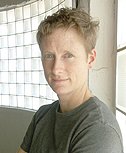Wednesday, January 4, 2006
January, 4, 2006
Michelle Acuff, a sculptor born and raised in Chicago who teaches at Millsaps, throws a hand outward toward a work in progress.
"I've been trying to push myself toward this more organic process," she explains, indicating a wood piece, "Tumult," that seems to squirm on the floor of her studio, alternately tossing itself outward and locking into itself at right angles. It could seem contradictory that you'd need to "push" yourself to be more "organic," but the piece exemplifi es the creative tension suggested by her statement. "Wood is a natural material, but it's been abstracted into sheets of plywood. So I'm trying to bring back the organic aspect."
Another work in progress evinces this strain as well. "Trauma" features handmade imitation institutional crutches splayed out on the floor, their ends bent upward and away from the ground, as if the crutches need help themselves. You almost feel like assisting them off the floor.
Before receiving her MFA in sculpture from the University of Iowa, Acuff spent four years in Ecuador teaching at the University of Cuenca, as well as founding La Canasta, a community-based art studio in the Andes mountains. She speaks of the contrast in daily materials there. Most roads are dirt, and the houses include more materials from the natural environment than houses in the States. "You go to the market and wrap (your purchase) up in a banana leaf," she says. Acuff 's stay in Ecuador taught her a greater sensitivity to her environment, which has since informed her work. I ask her what she thinks about sculpture designed and set in public spaces. "Most public sculpture I abhor," she says quickly. "Your average welded piece of metal is crap. It's decoration. You can't expect people to respond."
Acuff grants that there are exceptions, but she prefers galleries. "I rely on the sacred space of the gallery," she says. The intimacy that springs from her works—her more animate, recent pieces feel like living creatures in the room—demands focus from the viewer, and the gallery is the perfect chapel for that interaction.
For Acuff, the move to sculpture was gradual, and though she still "thinks by drawing," her major explorations are in the third dimension. Walking through her studio, you feel a bodily immediacy in relation to her work that is startling.
"You have to use your body. You can't just stand there, that's what I tell my students," she says.
She shows me a drawing of a sort of upside-down U, then points to the sculpture leaning against the wall, and the you feel like the sculpture is the vaguely biped-artifact in real-life and the drawing is some traveler's sketch.
Her earlier works are less organic, featuring more modest, formal structures, but are no less affecting. One, "Making the Mountain," is particularly striking. A structurally simplifi ed house stands 8-feet high, taller than a viewer but clearly representative of a real house. It appears frantically constructed. Arm's-length wood pieces look glued together haphazardly, giving the house a jumbled, overwrought facade. But it's still a house, a place for shelter and comfort. Acuff explains some of the context of the work's beginnings. It was partially conceived in the aftermath of 9/11.
"I saw the buildings go down, and my response as a sculptor was to build," she says.
The piece radiates haste and need, a symbolic, simplifi ed house-shape communicating shelter, its aura of comfort and safety belied by the freneticism of its construction.
The newer pieces, as Acuff describes them, "have curves" and "a tenuous relationship to the ground." We look at a last piece, "Animal," an interlocking tangle of oddly formed S's and 3's wrapped around one of her studio's vertical beams. "It's still about building materials and subverting their use," Acuff says, and the piece, made of plywood and silicone, illustrates the notion well: wrapped, tangled, alive but still as a picture, it seems to be pushing for its own autononmy.
Acuff will be showing her works in a faculty show in January at the Millsaps campus. Check out other works of art on her site at http://www.michelleacuff.com

Comments
Use the comment form below to begin a discussion about this content.
Sign in to comment
Or login with:
OpenID